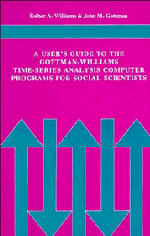Introduction
Published online by Cambridge University Press: 01 June 2011
Summary
These programs and this manual were written with beginners in mind. We have a lot of sympathy for researchers who have an idea of what they want to learn from their data and who hope for easily intelligible output. They would like a set of flexible, powerful programs that they can grow into as they learn about time-series analysis. They would be likely to avoid using programs that require a great deal of technical knowledge even to punch the control cards. For example, consider researchers who think their data may be cyclic. They skim a few chapters in a time-series book and learn that there is a thing called a spectral density function, and if that has a statistically significant peak, their data has a cycle at that particular frequency. Then they read the computer manual and find that they need to answer the question, “Which spectral window do you want to use? Punch 1 for Tukey-Hanning, 2 for Bartlett, 3 for Parzen, etc.” They are likely to be discouraged from ever using the program if they have to answer perplexing questions such as this.
What we have done is to make these decisions for the user by limiting the number of options. We have done this only when it makes very little practical difference which option is chosen. We specify the equations we use so that an experienced user can modify the programs to suit special needs.
Information
- Type
- Chapter
- Information
- A User's Guide to the Gottman-Williams Time-Series Analysis Computer Programs for Social Scientists , pp. 1 - 6Publisher: Cambridge University PressPrint publication year: 1982
